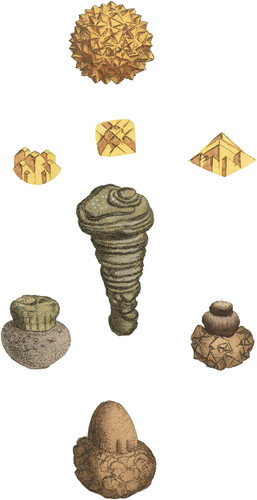 Enlarge
Enlarge
British Mineralogy
Sulphuret of Iron. Iron Pyrites
- Class 3. Metals.
- Order 1. Homogeneous.
- Gen. 7. Iron.
- Spec. 4. Sulphuret of.
- Div. 2. Imitative.
- Syn. Sulphret of Iron of particular Shapes. Bab. 204.
Sulphur and Iron in combination are very common, and the forms of such compounds are extremely various, both in regular crystallization and in the ruder states. The specimen in the upper figure was given me by the Rev. Mr. Charles Sutton, and it resembles such as have been formed in chalk with an ochraceous outside. It has greatly the appearance of the fruit of the Platanus Orientalis: the surface, however, is crystallized, in quadrangular pyramids, or half relieved octaëdrons, with or without truncations. This may convince the discerning that the form does not depend on the fruit of the plantanus, but is a form natural to itself, and curious for its regularity of appearance. The forms of the crystallization are magnified beneath, to show how curiously they connive, sometimes giving a floriform appearance. The next was found among the marly rocks at Sheppy Island, and seems to have been of a thickish consistence like treacle, dropping at intervals, and giving this singular formation of an inverted cone. The next figure, resembling a Mushroom-button, seems formed in a similar way, with trifling differences in the circumstances; as the lower figure does also, which resembles an Acorn. The crystallization and metallic appearance help to undeceive. However, this is not always the case; and even this might, from its rugosity, often having the appearance of the shagginess in a Mushroom, or of the squamæ on the cup of the Acorn, mislead those who do not pay regard to the crystallization natural to Pyrites. The cracks resembling stripes in the left-hand Mushroom-like figure help a little to favour the deception. It may not be amiss to observer, that on Sheppy Isle Mushrooms are extremely abundant; and this may have given rise to the idea of their being petrified, though any less fugatceous Fungus might have stood a better chance of being petrified. This sort of Pyrites is extremely common in argillaceous marl all over the kingdom, and it varies indefinitely.

